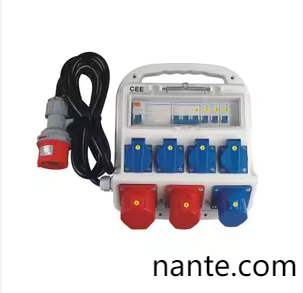As global industries face mounting pressure to balance productivity with precision, industrial socket box manufacturers are turning to advanced robotics to redefine their production paradigms. These rugged power distribution units, essential for construction sites, factories, and renewable energy projects, now benefit from automated systems that enhance quality, scalability, and sustainability—meeting today’s demands for agility in a rapidly evolving market.
Robotic Precision in Component Assembly
Modern industrial socket boxes require meticulous assembly to withstand extreme conditions, from dust-filled warehouses to offshore oil rigs. Robotic arms equipped with vision systems now handle tasks like welding corrosion-resistant enclosures and installing overload protection circuits with micron-level accuracy. This shift eliminates human error in critical stages, ensuring every unit meets international safety standards such as IEC and UL certifications. For instance, automated soldering systems apply consistent thermal profiles to connections, preventing weak joints that could lead to electrical failures—a vital upgrade as industries prioritize workplace safety .
AI-Driven Quality Control
Traditional manual inspections are no match for the complexity of modern socket box designs. Manufacturers now deploy AI-powered cameras and sensors to scan finished products for defects like micro-cracks or improper grounding. Machine learning algorithms analyze historical data to predict potential flaws in real time, enabling proactive adjustments during production. This approach not only reduces waste but also accelerates time-to-market for customized orders, such as explosion-proof variants for chemical plants or modular units for solar farms .
Sustainable Manufacturing Through Automation
The push for greener practices has transformed production lines. Robotic systems optimize material usage by precision-cutting ABS or steel enclosures, minimizing scrap. Energy recovery mechanisms in automated presses and injection molding machines further cut carbon footprints. Additionally, reusable modular designs—enabled by flexible robotics—allow manufacturers to refurbish and upgrade older units, aligning with circular economy principles increasingly demanded by European and North American markets .
Adapting to Labor and Supply Chain Challenges
With a third of skilled manufacturing workers nearing retirement, automation bridges the talent gap. Collaborative robots (cobots) now work alongside technicians to assemble complex components, combining human expertise with machine efficiency. This synergy is critical for industrial socket box manufacturers juggling volatile raw material costs and tariff-driven supply chain shifts. Automated inventory systems also track components like thermal relays and waterproof gaskets, ensuring just-in-time restocking to avoid project delays .
The Road Ahead: Smarter, Safer Power Solutions
The fusion of robotics and industrial expertise isn’t just reshaping factories—it’s redefining what’s possible in power distribution. As smart cities and renewable energy projects demand more adaptable infrastructure, automated production ensures socket boxes evolve to handle higher voltages, IoT integrations, and extreme climates.
For businesses seeking cutting-edge solutions that marry durability with innovation, www.nante.com stands at the forefront of this transformation, delivering robust power hubs engineered for tomorrow’s challenges.
